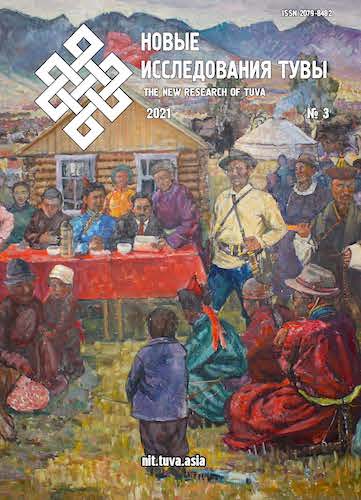Features of urban settlement in Tuva in the Soviet period
DOI:
https://doi.org/10.25178/nit.2021.3.11Keywords:
Tuva; history of Tuva; population; urbanization; socioeconomic development; urban settlingAbstract
The article examines various aspects of history of the rise of urban settlements in Tuva – towns and urban-type localities – in the latter half of the 20th century. The author focus primarily on contributing factors in economy (such as the development of industrial manufacturing) and in social life (e.g., improved housing and higher salaries for workers in urban settlements). Among the factors which contributed to the increase in urban population were the promotion of some existing settlements to urban status, incremental growth and labour-related migration from rural Tuva and other regions of Russia.
Statistical data included into the article shows the numerical strength of urban population from 1959 to 1989, including their share in the demographic of Tuva. By 1989, this share has reached 47.1%, with the difference between male and female populations of working age and beyond it quite negligible. The number of urban and rural households turned almost equal, and the population growth in the capital city of Kyzyl was high (27% of Tuva’s total in 1989).
Since mid-20th century, urban settling in Tuva has been unbalanced, which continues to be a major factor in the structure of urban population and its biggest problem – the ongoing migration of rural population to Kyzyl and its suburbs.
References
Anaiban, Z.V. (2011) Kharakteristika etnodemograficheskikh protsessov Tuvy v sovetskii period [A characteristics of ethnodemographic processes in Tuva during the Soviet period]. New Research of Tuva, no. 2–3, pp. 130–150. (In Russ.)
Begzi, A.D. (1975) Formirovanie gorodskogo naseleniia Tuvinskoi ASSR iizmenenie ego sotsial'noi struktury i natsional'nyi sostav [The rise of the urban population of the Tuvan ASSR and changes in its social and ethnic structure]. Uchenye zapiski TNIIIaLI, vol. XVII. Kyzyl, Tuvan book publisher. 278 p. Pp. 62–70. (In Russ.)
Begzi, A. D. (2017) Ekonomika sovetskoi Tuvy: dostizheniia, problemy i uroki [The economy of the Soviet Tuva: achievements, challenges and lessons]. New Research of Tuva, no. 4, pp. 94–108. (In Russ.). DOI: https://doi.org/10.25178/nit.2017.4.5
Begzi, A. D. (2019) Osnovnye faktory, etapy i osobennosti realizatsii urbanizatsii v Tuve. [The main factors, stages and features of urbanization in Tuva]. In: Regional'naia ekonomika: tekhnologii, ekonomika, ekologiia i infrastruktura [Regional Economy: Technologies, Economic Factors, Ecology and Infrastructure]: Proceedingss of the 3rd International Scientific and Practical Conference dedicated to the 25th anniversary of TuvIKOPR Sb RAS and the 45th anniversary of Academic Science in Tuva (23–25.10.2019, Kyzyl, Russia) / ed. by G. F. Balakina and V. O. Oorzhak. Kyzyl, TuvIKOPR SO RAN. 520 p. (In Russ.)
Gorodskoe naselenie Tuvinskoi ASSR [Urban population of the Tuvan ASSR] (1981) / ed. by V. I. Boiko. Novosibirsk, Nauka. 224 p. (In Russ.).
Grebnev, L.V. (1967) Formirovanie rabochego klassa v Tuve [The rise of the working class in Tuva]. Uchenye zapiski, vol. XII. Kyzyl, Tuvan book publisher. 278 p. Pp. 69–86. (In Russ.)
Grebnev, L.V. (1968) Izmenenie sotsial'noi struktury v Tuve [Changing the social structure in Tuva]. Uchenye zapiski, vol. XIII. Kyzyl, Tuvan book publisher. 356 p. Pp. 47–77. (In Russ.)
Istoriia Tuvy [The History Of Tuva] (2016): in 3 vols. / ed. by V. A. Lamin. Novosibirsk, Nauka. Vol. 3. 455 p. (In Russ.).
Na perekrestke vremeni [At the crossroads of time] (2014): a collection of archival documents and photo documents / eds.: A. M. Dugar-Surun et al. Novosibirsk, Sibirskoe knizhnoe izdatel'stvo. 480 p. (In Russ.).
Ocherki sotsial'nogo razvitiia Tuvinskoi ASSR [Essays on social development of the Tuvan ASSR] (1983) / ed. by Yu. L. Aranchyn. Novosibirsk, Nauka. 262 p. (In Russ.).
Serdobov, N.A. (1977) Rabochii klass i sotsial'no-ekonomicheskoe razvitie Tuvy [Working class and socio-economic development of Tuva]. In: Velikii oktiabr' i problemy noveishei istorii Tuvy [The Great October and the problems of the modern history of Tuva]. Ed. by Yu. L. Aranchin. Kyzyl, Tuvan book publisher. 147 p. Pp. 17–51. (In Russ.)
Tinikova, E. E. (2018) Transformatsiia gorodskogo rasseleniia v natsional'nykh respublikakh Iuzhnoi Sibiri v seredine XX — nachale XXI veka [Transformation of urban settlement in the national republics of southern Siberia in the mid-20th to early 21st century]. New Research of Tuva, no. 4, pp. 235–257. (In Russ.). DOI: https://doi.org/10.25178/nit.2018.4.13
Kharunova, M. M.-B. (2010) «Pasport» Tuvinskoi avtonomnoi oblasti kak istoricheskii istochnik [The “Passport” of the Tuva Autonomous Region as a historical source]. In: Uchenye zapiski, vol. XXII. Kyzyl, Tyvapoligraf. 503 p. Pp. 159–167. (In Russ.).
Ekonomika Tuvinskoi ASSR [The economy of Tuvan ASSR] (1973). Ed. by S. V. Klopov. Kyzyl, Tuvan book publishing house. 378 p. (In Russ.).
Published
How to Cite
For citation:
Kharunova M. M.-B. and Kharunov R. Sh. Osobennosti formirovaniia gorodskogo rasseleniia v Tuve v sovetskii period [Features of urban settlement in Tuva in the Soviet period]. New Research of Tuva, 2021, no. 3, pp. 137-147. (In Russ.). DOI: https://www.doi.org/10.25178/nit.2021.3.11
Issue
Section

This work is licensed under a Creative Commons Attribution-NonCommercial 4.0 International License.

Author(s) license holder(s) grant rights for their work to the journal (grantee of a license) under the simple non-exclusive open license in accordance with Art. 1286.1 «Open license for a research work, work of literature or fine arts», Civil Code of the Russian Federation.
New Research of Tuva publishes articles under the Creative Commons Attribution-NonCommercial license (CC BY-NC).
Since it is an open license, author(s) reserve the right to upload the article to their institutional repository, submit it to another journal (if it allows republications), or republish it on their own website (in full, or in part).
However, several conditions apply here:
a) The republished version must always contain the name(s) and affiliation(s) of the author(s), the original title and the hyperlink to the original version on the New Research of Tuva website;
b) It must be in open access, free of charge, and no category of readers must be in any way whatsoever advantaged over general readership.
c) should the contribution be submitted elsewhere by its author(s) without substantial modification (30% or more of original text unchanged), the body of the article should contain a disclaimer that the original version was published in New Research of Tuva (with a link to the respective page)
The CC-BY-NC is a non-revocable license which applies worldwide and lasts for the duration of the work’s copyright.










